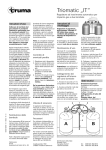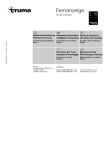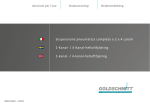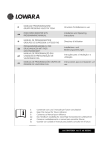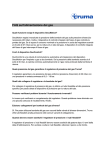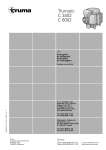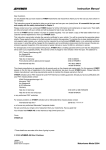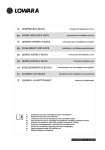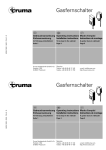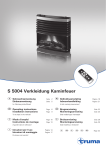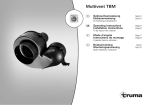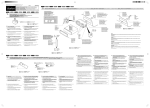Download Fernanzeige
Transcript
Fernanzeige Triomatic Triomatic Gebrauchsanweisung Einbauanweisung Seite 3 50020-43700 · 01 · 02/2007 · 2’B · © Im Fahrzeug mitzuführen! Operating instructions Installation instructions Bruksanvisning Monteringsanvisning Skall medföras i fordonet! Page 5 To be kept in the vehicle! Mode d’emploi Instructions de montage Page 7 À garder dans le véhicule ! Istruzioni per l’uso Istruzioni di montaggio Pagina 9 Da tenere nel veicolo! Truma Gerätetechnik GmbH & Co. KG Postfach 1252 85637 Putzbrunn Service Telefon +49 (0)89 4617-2142 Telefax +49 (0)89 4617-2159 [email protected] www.truma.com Sida 11 Fernanzeige Triomatic A B C 6 17 Ø m 55 m 14 10 12 Anschlussschema Connecting diagram Schéma de branchement Schema collegamenti Elanslutning 16 11 16 15 Fernanzeige für das Gasdruckregler-Set Triomatic Sommerbetrieb: Schalter nach unten (a). Die Leuchtdioden zeigen an, welche der beiden Flaschen das Gas liefert: grüne Leuchtdiode = Betriebsflasche (A), rote Leuchtdiode = Reserveflasche (B). Winterbetrieb: Um Störungen der Gasanlage im Winterbetrieb zu verhindern, kann die Fernanzeige durch ein oder zwei Eis-Ex (Art.-Nr. 53100-01) ergänzt werden. Gebrauchsanweisung Triomatic c d e Inbetriebnahme b a a = Ein (Sommerbetrieb) b = Aus c = Ein und Heizen (Winterbetrieb bei montiertem Eis-Ex – Sonderzubehör) d = Grüne Kontrollleuchte e = Rote Kontrollleuchte Schalter nach oben (c). Zusätzlich zur Anzeige wird der Betriebsregler (Bild A 1) beheizt. Mit einem zweiten Eis-Ex kann auch der Reserveregler (2) beheizt werden. Technische Daten Einbauanweisung Spannung: 12 V Stromaufnahme Sommerbetrieb: 1,5 mA Winterbetrieb mit Eis-Ex: 320/640 mA Gasrohranschluss: 8 mm Produkt-Ident-Nummer: CE-0085AS0417 Einbau und Reparatur der Fernanzeige darf nur vom Fachmann durchgeführt werden. Bei Verwendung von fahrzeug- bzw. herstellerspezifischen Bedienteilen, muss der elektrische Anschluss gemäß der Truma Schnittstellenbeschreibung erfolgen. Montage des Druckschalters 1. Bild A: Gasschlauch (3) am T-Stück (4) abschrauben. 2. Druckschalter (5) am T-Stück (4) anschrauben. 3. Gasschlauch (3) am Druckschalter (5) anschrauben. Der Druckschalter (5) muss in einer hängend senkrechten Einbaulage auf einer beliebigen Seite des T-Stücks montiert werden. 3 4. Das 2-polige Anschlusskabel (6) mit Isolierband parallel zum Anlagenregler (7) und Gasrohr (8) verlegen. 5. Kabel nach innen zum vorgesehenen Platz für das Bedienteil verlegen. Falls erforderlich, mit einem Kabel 2 x 0,75 mm² verlängern. Der elektrische Anschluss bzw. die Verbindung zu einer Kabelverlängerung darf nicht im Flaschenkasten erfolgen! Für Flaschenkasten-Durchführung (9) Gummitülle oder Karosseriedichtmittel verwenden. Durchführung mindestens 50 cm über dem Boden des Flaschenkastens – oder in einem Schutzrohr verlegt – vorsehen. Elektrischer Anschluss 1. Bild C: Platz für das Bedienteil (10) an gut sichtbarer Stelle vorsehen. Ist eine Unterputzmontage des Bedienteils nicht möglich, liefert Truma auf Wunsch einen Aufputzrahmen (11 – Art.-Nr. 4000052600) als Sonderzubehör. 2. Loch Ø 55 mm bohren. Anschlusskabel des Druckschalters (6) und 12 V Zuleitung (17) von hinten durch die Bohrung in der Wand führen und gemäß Anschlussschema am Bedienteil anklemmen. Bild B: Anschlussschema 1 = Zuleitung Plus 12 V 2 = Zuleitung Minus 3 = Eis-Ex 4 = Eis-Ex 5 = Minusleitung (schwarz) vom Druckschalter 6 = Plusleitung (rot) vom Druckschalter Die Klemmen 3 und 4 sind für den Anschluss von einem oder zwei Eis-Ex vorgesehen. Diese Anschlusskabel können beliebig angeklemmt werden. 4 3. Bild C: Hintere Abdeckkappe (14) als Zugentlastung aufsetzen und Bedienteil (10) mit 4 Schrauben (12) befestigen. Anschließend Abdeckrahmen (15) aufstecken. den Trafo-Stecker kann nur ein Eis-Ex betrieben werden (ein Anschluss von weiteren 12 V-Geräten ist nicht möglich). Als Abschluss zum Abdeckrahmen liefert Truma als Sonderzubehör Seitenteile (16). Funktionsprüfung 4. Gerät am abgesicherten Bordnetz (Zentralelektrik 5 – 10 A) mit Kabel 2 x 0,75 mm² anschließen. Minusleitung an Zentralmasse. Bei direktem Anschluss an die Batterie ist die Plus- und Minusleitung abzusichern. Bei Verwendung von Netzteilen ist zu beachten, dass die Ausgangsspannung zwischen 11 V und 15 V liegt und die Wechselspannungswelligkeit < 1,2 Vss beträgt. Die Fernanzeige kann über den Truma Trafostecker (Art.-Nr. 53110-01) auch mit 230 V betrieben werden. Der Trafostecker liefert 12 V Wechselstrom mit geringer Leistung. Die zwei Kabel am Trafostecker können beliebig angeklemmt werden. Über Nach dem Einbau muss die Dichtigkeit der Gaszuleitung nach der Druckabfallmethode geprüft werden. Anschließend gemäß der Gebrauchsanweisung sämtliche Funktionen prüfen. Die Gebrauchsanweisung ist dem Betreiber auszuhändigen. Remote indicator for the Triomatic Gas Pressure Regulator Set Summer operation: Move the switch down to (a). The LED's indicate which of the two cylinders is supplying the gas: green LED = operating cylinder (A), red LED = reserve cylinder (B). Winter operation: To prevent malfunctions of the gas system during winter operation, the remote indicator can be supplemented with one or two defroster (Eis-Ex – part no. 53100-01). Operating instructions Triomatic c d e Switching on b a Move the switch up to (c). The operating regulator (fig. A 1) is now heated in addition to indicating the cylinder in operation. A second defroster (Eis-Ex) can also heat the reserve regulator (2). Technical data Voltage: 12 V Current input summer operation: 1,5 mA winter operation with defroster (Eis-Ex): 320/640 mA Gas pipe connection: 8 mm Product Ident.Number: CE-0085AS0417 Installation instructions Installation and repair work to the remote indicator is only to be carried out by an expert. When using specific vehicle or manufacturer control panels, the electrical connection must be in accordance with the Truma interface description. Assembly of pressure switch 1. Fig. A: Unscrew gas hose (3) at T-piece (4). 2. Screw pressure switch (5) to T-piece (4). 3. Screw gas hose (3) to pressure switch (5). a = On (summer operation) b = Off c = On and Heat (winter operation with Eis-Ex ice preventer fitted – special accessory) d = green indictor lamp e = red indicator lamp The pressure switch (5) must be fitted in a suspended vertical installation location on whichever side of the T-piece is most convenient. 5 4. Route the 2-pole connecting cable (6) with insulating tape parallel to the system regulator (7) and gas pipe (8). 5. Route cable to the inside, to the place where the control panel is to be installed. Lengthen using a 2 x 0.75 mm² cable, if necessary. The electrical connection or the connection to a cable extension must not be effected in the cylinder container. For passing cables through a cylinder container (9), use rubber grommets or bodywork sealing material. Establish the cable run at least 50 cm above the base of the cylinder container, or lay it inside a protective tube. Electrical connection 1. Fig. C: Choose a place for the control panel (10) in a position which is easy to view. If it is not possible to install the control panel flush with the surface, Truma can provide a surface-mounting frame (11) on request, as a special accessory (part no. 40000-52600). 2. Drill two holes of 55 mm diameter. Guide the connection cable for the pressure switch (6) and the 12 V feed cable (17) from the rear through the drillhole in the wall and connect it to the control panel in accordance with the connecting diagram. Fig. B: Connecting diagram 1 = Feed cable, 12 V positive 2 = Feed cable, negative 3 = Eis-Ex ice preventer 4 = Eis-Ex ice preventer 5 = Negative lead (black) from pressure switch 6 = Positive lead (red) from pressure switch The terminals 3 and 4 are intended for the connection of one or two Eis-Ex ice preventers. These connection 6 cables can be connected wherever convenient. 3. Fig. C: Fit the rear cover cap (14) as a stress-relieving device, then secure the control panel (10) with 4 screws (12) and fit the cover frame (15). Truma can supply side pieces (16) as special accessories to round off the cover frame. 4. Connect appliance to fused vehicle power supply (central electrical system 5 – 10 A) using a cable 2 x 0.75 mm². The negative lead is to be connected to the central ground. When connecting directly to the battery, always fuse the positive and negative lead. When power supplies are being used, it must be noted that the output voltage is between 11 V and 15 V and the alternating current ripple is < 1.2 Vpp. With the Truma transformer connector (part no. 53110-01) the remote indicator can also be operated with 230 V. The transformer connector supplies a 12 V alternating current with low power. The two cables on the transformer connector can be connected in any order. With the transformer connector it is only possible to operate one defroster (Eis-Ex – it is not possible to connect any other 12 V appliances). Function test After installation the sealing tightness of the gas pipe must be tested, by using the pressure drop method; thereafter, check all functions in accordance with the Operating instructions. The Operating Instructions are to be handed over to the user. Affichage à distance pour l’ensemble de régulation de pression du gaz Triomatic Mode d’emploi Triomatic c d e b a a = Marche (service d’été) b = Arrêt c = Marche et Chauffage (exploitation hivernale en installant l’accessoire spécial Eis-Ex) d = Lampe-témoin verte e = Lampe-témoin rouge Mise en service Service d’été : Pousser le commutateur vers le bas (a). La diode électroluminescente montre laquelle des deux bouteilles fournit le gaz : diode électroluminescente verte = bouteille de service (A), diode électroluminescente rouge = bouteille de réserve (B). Service d’hiver : Pour éviter des incidents de fonctionnement en hiver, on peut compléter le télé-affichage par un ou deux dispositifs Eis-Ex (nº d’art. 53100-01). Pousser le commutateur vers le haut (c). En plus de l’affichage, le détendeur de service (fig. A 1) est chauffé. Avec un deuxième Eis-Ex, on peut chauffer aussi le détendeur de réserve (2). Caractéristiques techniques Tension : 12 V Consommation de courant service d’ete : 1,5 mA service d’hiver avec Eis-Ex : 320/640 mA Raccordement de gaz : 8 mm N° d’ident. du produit : CE-0085AS0417 Instructions de montage Le montage et les réparations du télé-affichage ne doivent être effectués que par un spécialiste. Si on utilise des pièces de commande adaptées aux spécificités et exigences des différents véhicules et fabricants, le branchement électrique doit être effectué selon la description de l’interface. Montage du manocontacteur 1. Fig. A : dévisser le flexible de gaz (3) sur le raccord en T (4). 2. Visser le manocontacteur (5) sur le raccord en T (4). 3. Visser le flexible de gaz (3) sur le manocontacteur (5). Le manocontacteur (5) doit être suspendu en position verticale sur l’un des côtés de l’élément en T. 7 4. Avec un ruban isolant, installer le câble de branchement à 2 fils (6) parallèlement au détendeur de sortie (7) et à la conduite de gaz (8). 5. Installer le câble vers l’intérieur jusqu'à l’emplacement prévu pour la pièce de commande. Si nécessaire, le rallonger avec un câble de 2 x 0,75 mm². Le raccordement électrique ainsi que la connexion à un câble de rallonge ne doit pas se faire dans la caisse des bouteilles ! Pour le passage à travers la caisse des bouteilles (9), utiliser un passe-câble en caoutchouc ou un système d’étanchéité pour carrosserie. Prévoir le passage au moins 50 cm au-dessus du fond de la caisse des bouteilles – ou installé dans un tube protecteur. 8 Branchement électrique 1. Fig. C : prévoir une place bien visible pour la pièce de commande (10). Si un montage sous crépi des pièces de commande n’est pas possible, Truma peut livrer, sur demande, un cadre de crépissage (11 – n° d’art. : 40000-52600) que vous trouverez sous les accessoires spéciaux. 2. Percer un trou de diamètre 55 mm. Introduire dans le mur le câble de raccordement du manocontacteur (6), ainsi que la conduite d’alimentation 12 V (17), par l’arrière, à travers le trou, puis les raccorder à la pièce de commande conformément au schéma des connexions. Fig. B : Schéma des connexions 1 = Conduite d’alimentation Plus 12 V 2 = Conduite d’alimentation Moins 3 = Eis-Ex 4 = Eis-Ex 5 = Conducteur moins (noir) du manocontacteur 6 = Conducteur plus (rouge) du manocontacteur Les bornes de connexion 3 et 4 sont prévues pour le raccordement d’un ou de deux dispositifs Eis-Ex. Ces câbles de raccordement peuvent être connectés de manière quelconque. 3. Fig. C : installer le capuchon de protection arrière (14) qui servira de décharge de traction, puis fixer l’organe de commande (10) à l’aide de 4 vis (12). Pour finir, poser le cadre de protection (15). Pour obtenir une finition propre du cadre de protection, Truma fournit, en accessoires spéciaux, des pièces latérales (16). 4. Brancher l'appareil protégé par un fusible (installation électrique centrale 5 – 10 A) au réseau de bord avec un câble de 2 x 0,75 mm². Brancher le fil moins à la masse centrale. En cas de branchement direct à la batterie, protéger les fils plus et moins. En cas d‘utilisation de blocs d‘alimentation secteur, veiller à ce que la tension de sortie soit située entre 11 V et 15 V et l‘ondulation de tension alternative < 1,2 Vss. Moyennant la fiche à transformateur intégré Truma (n° d’art. 53110-01), le télé-affichage peut aussi être utilisé sur 230 V. La fiche à transformateur délivre du courant alternatif 12 V de faible puissance. Les deux fils de branchement à la fiche peuvent être branchés de façon quelconque. Par la fiche à transformateur, on ne peut faire fonctionner qu’un seul Eis-Ex (le branchement d’autres appareils en 12 V n’est pas possible). Contrôle du bon fonctionnement Après avoir effectué l’installation, il faut contrôler l’étanchéité de la conduite d’alimentation en gaz suivant la méthode de la chute de pression. Vérifier ensuite l’ensemble des fonctionnalités en se conformant au mode d’emploi. Le mode d’emploi doit être remis à l’exploitant. Indicazione a distanza per il set di regolazione della pressione del gas Triomatic Istruzioni per l’uso Triomatic c d e b a a = acceso (funzionamento estivo) b = spento c = acceso e riscaldamento (funzionamento invernale in caso sia montato l'accessorio speciale Eis-Ex) d = spia luminosa verde e = spia luminosa rossa Messa in funzione Funzionamento estivo: Premere l’interruttore verso il basso (a). Le spie luminose indicano quale delle due bombole sta erogando gas: Spia verde: bombola principale (A) Spia rossa: bombola di riserva (B) Funzionamento invernale: Per evitare anomalie dell’impianto a gas con modalità di funzionamento invernale l’indicatore a distanza può essere integrato da uno o due Eis-Ex (n° art. 53100-01). Premere l’interruttore verso l’alto (c). La spia si accende e il regolatore principale (figura A 1) si riscalda. Montando un secondo Eis-Ex è possibile scaldare anche il regolatore di riserva (2). Dati tecnici Tensione: 12 V Corrente assorbita Funzionamento estivo: 1,5≈mA Funzionamento invernale con Eis-Ex: 320/640 mA Collegamento al tubo del gas: 8 mm Codice identificativo prodotto: CE-0085AS0417 Istruzioni di montaggio Il montaggio e la riparazione dell’indicatore a distanza devono essere eseguiti solo da un tecnico. In caso di utilizzo di elementi di comando specifici del veicolo o della casa produttrice, l’allacciamento elettrico dovrà essere effettuato in base a quanto indicato nella descrizione delle interfacce Truma. Montaggio del pressostato 1. Figura A: Svitare il flessibile del gas (3) dal raccordo a T (4). 2. Avvitare il pressostato (5) al raccordo a T (4) 3. Avvitare il flessibile del gas (3) al pressostato (5). Il pressostato (5) deve essere collocato in una posizione di montaggio perpendicolare e sospesa su uno qualsiasi dei due lati del raccordo a T. 9 4. Condurre il cavo di collegamento a 2 poli (6) parallelamente al regolatore dell’impianto (7) e al flessibile del gas (8) fissandolo con nastro isolante. 5. Portare il cavo verso l’interno nel punto previsto per il dispositivo di azionamento. Se necessario applicare un cavo di prolunga da 2 x 0,75 mm². Non realizzare l'allacciamento elettrico e/o il collegamento a una prolunga all'interno del vano bombole! Approntare il vano bombole (9) utilizzando una bussola di gomma o guarnizioni per carrozzeria. Montare il pezzo ad almeno 50 cm dal fondo del vano bombole, oppure inserirlo in un tubo di protezione. Collegamento elettrico 6 = linea positiva (rossa) dal pressostato l‘oscillazione della tensione alternata sia < 1,2 Vss. 1. Figura C: Prevedere la sistemazione del quadro di comando (10) in un punto ben visibile. I morsetti 3 e 4 sono riservati all'allacciamento di uno o due Eis-Ex. Tali cavi di allacciamento possono essere collegati a piacere. L’indicatore a distanza può essere azionato anche a 230 V mediante la spina del trasformatore Truma (n° art. 53110-01) che fornisce corrente alternata a 12 V a bassa potenza. I due cavi possono essere collegati indistintamente alla spina del trasformatore. Mediante questa spina è possibile azionare un solo Eis-Ex (sicurezza antigelo). Non si possono collegare altri apparecchi a 12 V. Se non è possibile un montaggio incassato dei quadri di comando, Truma fornisce dietro richiesta un telaio per montagggio non incassato (11 – n° art. 4000052600) come accessorio speciale. 2. Praticare un foro di Ø 55 mm. Passare il cavo di allacciamento del pressostato (6) e la linea di alimentazione a 12 V (17) da dietro attraverso il foro nella parete ed effettuare il collegamento al dispositivo di comando secondo lo schema di allacciamento. Figura B: Schema di allacciamento 1 = linea di alimentazione Più 12 V 2 = linea di alimentazione Meno 3 = Eis-Ex 4 = Eis-Ex 5 = linea negativa (nera) dal pressostato 10 3. Figura C: Applicare il cappuccio di copertura (14) per scaricare la trazione e fissare il quadro di comando (10) con 4 viti (12). Quindi inserire il telaio di copertura (15). Truma fornisce parti accessorie speciali da applicare come terminazioni ai lati della mascherina di copertura (16). 4. Utilizzare un cavo da 2 x 0,75 mm² per collegare l’apparecchio all’alimentazione di bordo adeguatamente protetta (centralina elettricità 5 – 10 A). Collegare il cavo negativo alla terra centrale. In caso di collegamento diretto alla batteria inserire una protezione per il cavo positivo e quello negativo. Se si utilizzano alimentatori, assicurarsi che la tensione di uscita sia compresa tra 11 V e 15 V e che Verifica del funzionamento Dopo il montaggio è necessario verificare la tenuta del tubo di entrata del gas secondo il metodo a caduta di pressione. Quindi verificare tutte le funzioni secondo quanto specificato nelle istruzioni per l'uso. Le istruzioni per l'uso devono essere consegnate all'utilizzatore dell'impianto. Fjärrindikering för gastrycksreglersatsen Triomatic Sommardrift: Tryck ner knappen till läge (a). Lamporna indikerar vilken av gasolflaskorna som är i drift. Grön lampa = Driftsflaska (A). Röd lampa = Reservflaska (B). Vinterdrift: För att undvika störningar i gassystemet vintertid kan fjärrindikatorn utrustas med en defroster (Eis-Ex, art.nr 53100-01). Bruksanvisning Triomatic c d e Igångsättning: b a a = On (sommardrift) b = Off c = Till och Värmning (vinterdrift vid monterat Eis-Ex (frysskydd – extra tillbehör) d = Grön indikeringslampa e = Röd indikeringslampa Tryck upp knappen till läge (c). Ventilen på driftsflaskan (bild A 1) värms nu upp och indikering sker även av vilken flaska som är i drift. Även reservflaskans ventil (2) kan utrustas med en defroster. Tekniska data Spänning: 12 V Strömförbrukning: 1,5 mA utan defroster 320/640 mA med defroster Gasrörsanslutning: Ø 8 mm Produkt ID: CE-0085AS0417 Monteringsanvisning Installation och service av denna produkt får endast utföras av fackman. Vid användande av fordonsrespektive tillverkarspecifika kontrollpaneler måste den elektriska anslutningen utföras enligt Trumas kopplingsschema. Montering av kontrollpanelen 1. Bild A: Skruva bort gasslangen (3) från T-stycket (4). 2. Skruva på kontrollpanelen (5) på T-stycket (4). 3. Skruva på gasslangen (3) på kontrollpanelen (5). Tryckvakten (5) måste installeras hängande i lodrätt läge på valfri sida av T-stycket. 4. Fäst den 2-poliga kabeln (6) med isoleringstejp parallellt med gasreglaget (7) och gasröret (8). 11 5. Dra kabeln in i fordonet, till den plats där kontrollpanelen skall installeras. Om förlängning blir nödvändig, använd 2 x 0,75 mm². El-installation Den elektriska anslutningen resp. förbindelsen till en förlängningskabel får inte ske i gasolkofferten! Är ett infällt montage av manöverdelen inte möjligt, levererar Truma på begäran en ram för utanpåliggande montage (11 – art.nr 40000-52600) som specialtillbehör. Använd gummihylsa eller karosseritätningsmedel för genomföringen i gasolkofferten (9). Planera genomföringen minst 50 cm över golvet i gasolkofferten – eller dra den i ett skyddsrör. 1. Bild C: Montera manöverpanelen (10) på väl synlig plats. 2. Borra ett hål Ø 55 mm. För bakifrån in anslutningskabeln för tryckvakten (6) och inkommande ledningen (17) för 12 V genom hålet i väggen och anslut enligt kopplingsschemat på manöverdelen. Bild B: Kopplingsschema 1 = Inkommande ledning plus 12 V 2 = Inkommande ledning minus 3 = Eis-Ex 4 = Eis-Ex 5 = Minusledning (svart) från tryckvakten 6 = Plusledning (röd) från tryckvakten Klämmorna 3 och 4 är avsedda för anslutning av ett eller två frysskydd. Dessa anslutningskablar kan anslutas godtyckligt. 12 3. Bild C: Använd den bakre täckkåpan (14) som dragavlastare och skruva därefter fast panelen (10) med 4 skruvar (12). Fäst därefter täckramen (15). Som avslutning för täckramen levererar Truma sidodelar (16) som extra tillbehör. 4. Anslut därefter fjärrindikatorn till fordonets avsäkrade strömförsörjning (elcentral 5 – 10 A) med en kabel 2 x 0,75 mm². Anslut minuskabeln till jord. Vid anslutning direkt till batteriet måste alltid plus- och minuskablarna avsäkras. När nätdelar används måste tillses att utgångsspänningen ligger mellan 11 V och 15 V och att växelspänningens pulsation uppgår till < 1,2 VSS. Med en Truma transformator, art.nr 53110-01 kan fjärrindikatorn även styras med 230 V. Transformatorn levererar 12 V svagström och de två kablarna kan anslutas valfritt. Endast en defroster (Eis-Ex) kan styras över transformatorn. Anslutning av andra 12 V apparater är inte möjlig. Funktionskontroll Efter montaget måste tätheten hos inkommande gasledningen kontrolleras enligt tryckfallsmetoden. I anslutning härtill skall samtliga funktioner kontrolleras enligt bruksanvisningen. Bruksanvisningen skall överlämnas till användaren.












